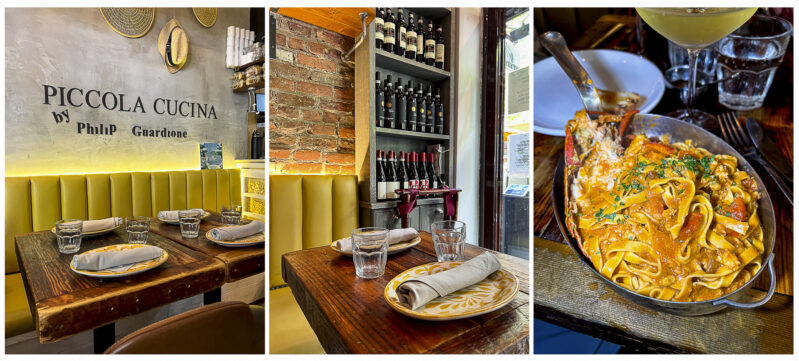Restaurants in New York: the best addresses
Whether you opt for a quick bite at a food truck or a cozy dinner at a trendy place, New York is bursting with restaurants and eateries. The choices are endless. Do you prefer 100% local, or would you rather explore world cuisine? You'll soon lose yourself in the offerings that reflect the multicultural makeup of the city and its people.
During my recent trip to The Big Apple, I discovered some fun and trendy addresses. I'm happy to tell you all about them in this blog.

Daily Provisions
I never eat a full breakfast and like to explore a nice coffee house near my hotel. At the Manhattan West Plaza on 33rd Street, I stumbled upon Daily Provisions, the ideal place for breakfast or a quick lunch. Eat-in at one of the high tables or on the cozy patio; or order your breakfast to-go. Pastries, sandwiches, salads or soup, everything is prepared in-house with fresh products of very good quality. I enjoy a perfect cappuccino and a delicious oatmeal cookie on the sunny terrace. The cookie is chewy and soft, tastes like molasses and contains big, juicy raisins. When I get home, I absolutely must make my own cookies.

Commerce Inn
For our first evening, I reserved a table at the Commerce Inn restaurant, located in the charming and historic West Village. The restaurant is decorated in Shaker style. The Shakers are an 18th-century, Christian, religious sect from Northwest England that crossed over to early America, specifically the Northeast Coast. The restaurant resembles an Early American tavern from the 1900s. The decor is clean and simple but cozy with lots of wood and a nod to days gone by.
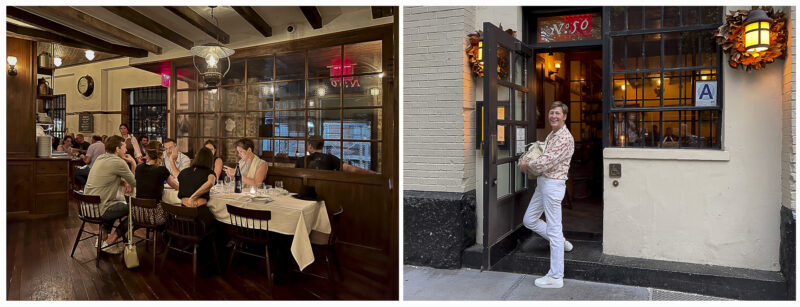
What can you eat at The Commerce Inn?
The dishes are based on historical recipes and the wine list offers wines from small, American producers. The preparations are unpretentious and the ingredients of very good quality. The portions are generous. There is a choice of daily specials in addition to the regular menu that includes a nice selection of vegetarian dishes. I eat oven-baked sea bass with fennel. Didier chooses perfectly roasted lamb chops served on a layer of braised broad beans with a meat gravy with garlic and fresh herbs. Highly recommended!
Taste the Commerce Inn at your home with my recipe of oven-baked sea bream with fennel
Cull + Pistol
I already told you about the Lobster Place in my blog about culinary discoveries in New York. This impressive food hall of fish and seafood in Chealsea Market has, in addition to the bars where you can sample all kinds of preparations, the cozy and quiet restaurant Cull + Pistol.
The menu
At Cull + Pistol, you can choose between a set menu of seafood preparations and an oyster menu. This menu changes daily according to the supply of oysters. They are arranged geographically from the northeast coast of the United States to the southwest coast. We put together a platter of 6 types of oysters, a serving of king crab and a preparation of scallops with yuzu. The oysters are surprisingly small but very tasty and fresh. The king crab is sweet and juicy. The carpaccio of scallops, caught in Massachusetts, is a heavenly preparation of the very best quality. We continued our meal with roasted shishito peppers with fish sauce and smoked salt, a surprising dish with a barbecue touch. This is followed by the aromatic, grilled Spanish octopus with chorizo and roasted red peppers. We leave Cull + Pistol feeling delighted and satisfied.
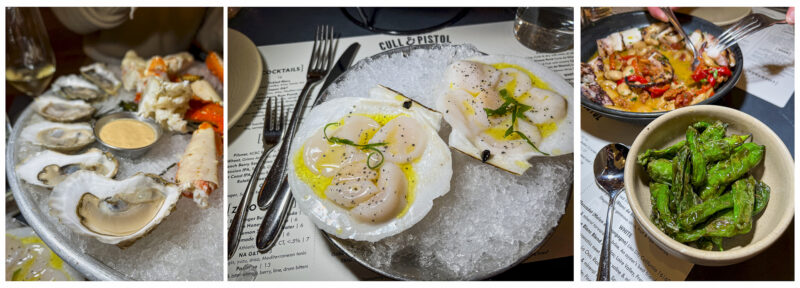
Keen’s Steakhouse
Are you a meat lover? Then a visit to the historic restaurant Keen's will not disappoint you. Keen's is one of New York's oldest steakhouses and is best known for its mutton chop. There is a cozy-loud atmosphere in this old historic tavern with classic wood furnishings. Several dining rooms are spread out over different floors. The tables are lined with white linen and the service is very prompt and friendly.
The special part about the interior is the ceiling with its 50,000 old clay pipes.
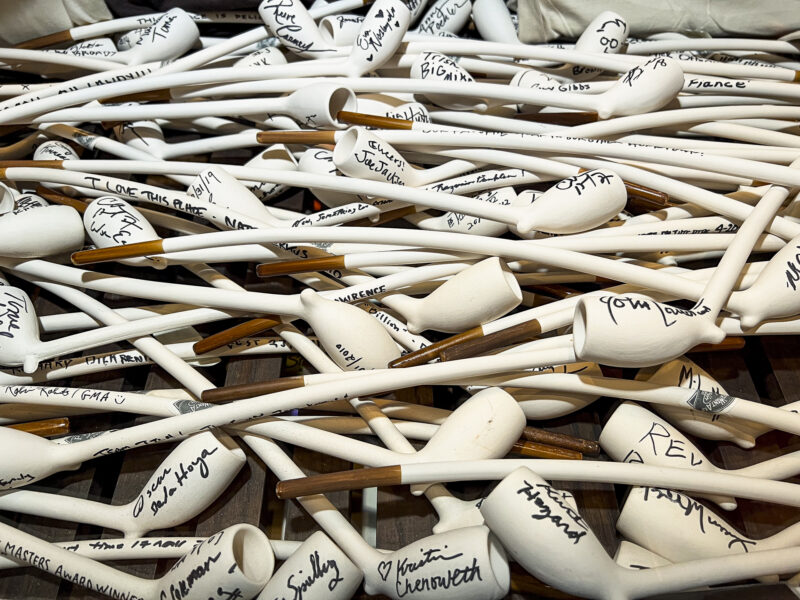
The tradition of the clay pipe
After the discovery and introduction of tobacco from South America, an increasing number of sailors and soldiers began to smoke. Hence, they used a clay pipe. The craft of the clay pipe originated in England during the reign of Elisabeth I, in the second half of the 16th century. The English pipe makers were usually soldiers who took their knowledge and tools to surrounding countries. They made the pipes from white clay they brought with them from England. In the 17th century, the center of clay pipe production shifted to the city of Gouda, in the Netherlands. They were the best clay pipes on the market and were exported to all corners of the world. Smoking a pipe, at that time, was considered beneficial for expelling the "evil course of the brain." In the 18th century, the shank of the clay pipe became longer and thinner. The pipes were extremely fragile and not suitable for carrying in hand- and saddlebags. For that reason, many travelers kept their clay pipes in their favorite inn.
Keen's Pipe Club
Albert Keen, director of a famous London theater company, came to New York's bustling Theatre District in the late 19th century. In 1885, he opened Keen's Chophouse and began the pipe tradition at Keen's Pipe Club. Every three years he imported 50,000 clay pipes from Holland. A supervisor kept and registered the pipes for the customers. Members included producers, playwrights and publishers as well as such well-known characters as Teddy Roosevelt, Babe Ruth, Will Rogers, Albert Einstein, J.P. Morgan, General Douglas MacArthur and "Buffalo Bill" Cody. Their clay pipes still adorn the ceilings and walls of Keen's Steakhouse.
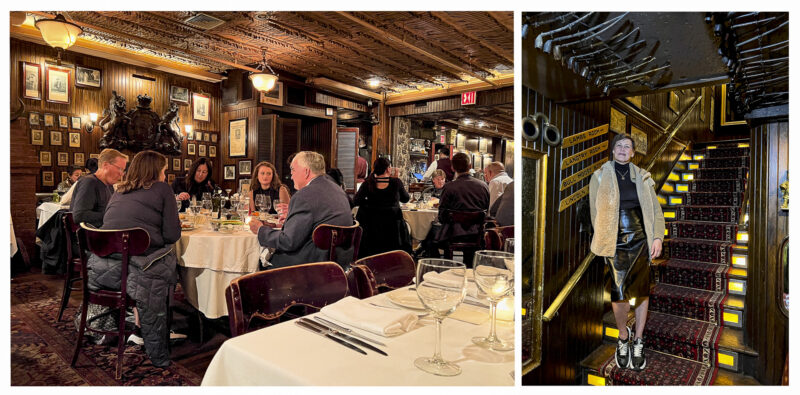
Keen’s mutton chop
When visiting Keen's Steakhouse, you absolutely must taste the legendary mutton chop. The chop is a 6-inch high, whole loin piece with tenderloin and side flap included. The mutton chop is roasted to perfection and the meat is tender and juicy. Don't be put off by the word mutton. The meat comes from a right on the cusp yearling, so technically it is no longer a lamb. The dish is served with braised escarole and fresh mint jelly. Finger licking delicious!
We choose another classic of American cuisine: steak and lobster. A beautiful piece of beef tenderloin from Certified Angus Beef with the tail of a steamed Maine lobster appears on our plate. On the side comes a delicate meat sauce and a portion of fries. The meat is flavorful and tender, the lobster sweet and juicy.
Steak and lobster, a typical surf & turf dish from American cuisine. It's almost barbecue season and I can't wait to make this classic myself.
Steak and lobster, an American classic (button)
Cosme
Exquisite Mexican dishes in a hip and contemporary interior. Cosme is all about top quality, refined taste and great service. There is a casual, friendly buzz in this no-nonsense restaurant located in the Flatiron District. Cosme is the brainchild of Enrique Olvera, top chef and owner of Mexico City's Pujol, a must-visit on my bucket list.
Mexican wine
We choose a Mexican wine from Valle de Guadalupe, a region in Baja California, Mexico. Wine has been grown in this region since the Conquistadores. The Spanish colonists needed wine for the Eucharist and could not continue to import it from Spain. So, the Spanish government encouraged them to grow grapes for this noble task. The wine was destined mainly for the church and was called "mission." Until recently, there were only 49 wineries in Baja California. Now there are more than 150. Baja California is now on the map as a major wine destination.
The Vena Cava Big Blend is made from Syrah, Cabernet Sauvignon, Zinfandel, Petite Sirah and Grenache. The wine has a deep red color and aromas of red and black berries, plums, clove and licorice with hints of tobacco and coffee. A beautiful discovery!
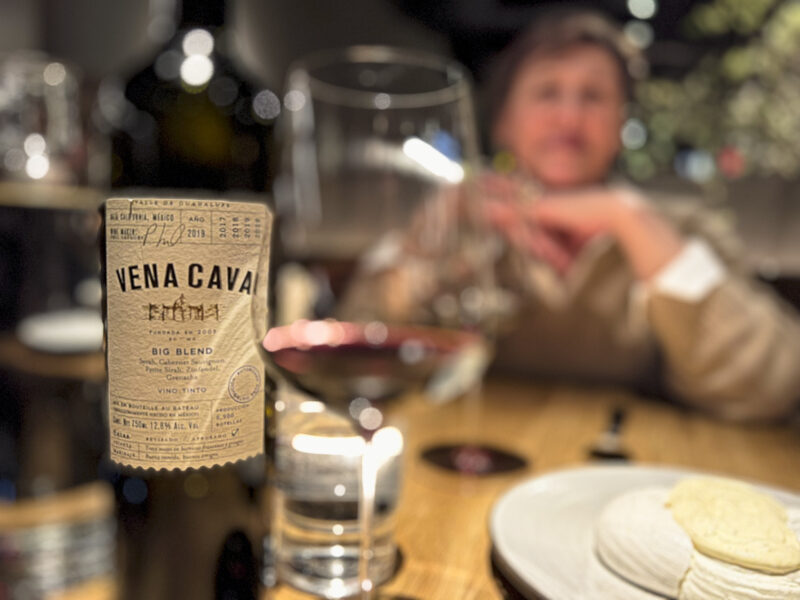
Sharing dishes
Cosme works with the concept of sharing dishes, a formula in which several small portions are shared by everyone at the table.
We start with a fresh herb guacamole with corn chips, followed by a tostada with arctic char, a salmon-like fish from the Arctic. Fine slices of fish and avocado lie on a layer of puree made with smoked chilies and chicatana ants. This delicacy from Oaxaca adds a slightly spicy and smoky touch to the dish. The next dish is a tiradito of yellowtail kingfish, a south ocean fish known for its delicate flavor, prepared with shiso leaf and rhubarb marinade. What results is a complete hit! We continue the tasting with lobster al pastor. "Al pastor" refers to a specific sauce made with chili peppers, garlic and vinegar. The traditional al pastor preparation is a taco filled with marinated pork, onion and cilantro and sometimes pineapple. At Cosme, the juicy pieces of lobster are served with a tartar of pineapple, a cream of pineapple and the aromatic al pastor chili sauce. I can't wait to make my own tacos al pastor at home.
Signature dessert
I am tempted to try the cornhusk meringue. It is Cosme's signature dessert. A crispy meringue is served with vanilla whipped cream and cream of mascarpone and corn. The finishing touch includes powdered roasted cob leaves and salt. The salty-sweet dessert is velvety and the taste of corn subtle. Chef Enrique Olvera published the recipe for this unique dessert in his cookbook Mexico from the Inside Out. I am happy to share it with you in my blog.
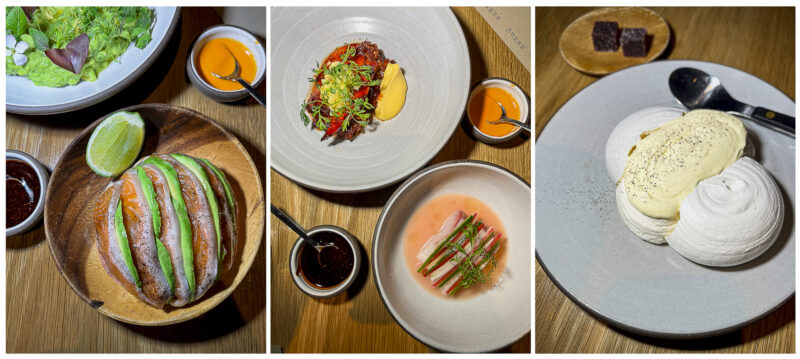
53
53 is the epitome of contemporary Asian cuisine in a decor fit for a king. The beautiful modern Art Deco-style dining room is spread over 3 levels and exudes warmth and class. Located right next to MoMA, the restaurant is under the direction of chef Akmal Anuar. Chef Anuar is the celebrity chef from Singapore who rose from his parents' food stall to become the best restaurant in Asia according to the Pelegrino World's Best list. He values quality, precision and detail, and his dishes exude that work ethic. He manages to elevate typical dim sum, stir-fries, and fried rice to a heavenly level. Each of the dishes is executed to perfection. Before I finish my meal, I'm already thinking about coming back.
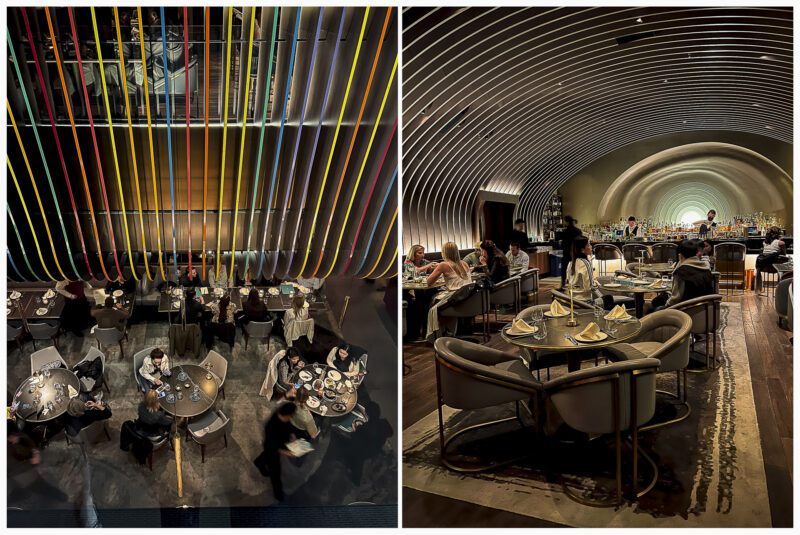
What we eat at 53
Carpaccio! Both salmon and beef. We get a plate with a nice portion of top-quality fresh salmon finished with sesame oil, lime and shio kombu. The beef carpaccio is topped with Szechuan peppercorns and crispy fried leeks. Both dishes are simple and well balanced in flavor. An excellent suggestion.
Next, we choose chicken wings with sweet soy sauce and togarashi. How sophisticated can you make a chicken wing? The wing was deboned, juicy, sweet and spicy given the Japanese spice mix. The lacquered lamb rib with barbecue yogurt sauce that follows, is no less exquisite than the chicken wings. Both are dishes of the highest order.
Then comes the duck clay pot, a clay pot dish of rice and duck confit with five-spice, Thai basil and cilantro leaf. The deeper you spoon into the pot, the crunchier the rice becomes. Again, the dish is a hit.

Emily Lew, the service manager, kindly offers us the eel club. It is indeed a dish not to be missed. The combination of creamy sauteed duck liver with sweet-savory unagi, Japanese freshwater eel, and pear is heavenly.
We top off our evening with a delicious scoop of ice cream made from gula melaka, Malaysian palm sugar, and a scoop of hojicha ice cream. Hojicha is roasted Japanese green tea. Our visit to 53 is one of the highlights of our New York trip.
Piccola Cucina Sicilian Osteria
We spent our last day in NYC with a stroll through the beautiful streets of SoHo. Coincidence brings us to the small, cozy Piccola Cucina Sicilian Osteria from the group Piccola Cucina by Philip Guardione. Chef Guardione grew up in Sicily at the foot of Mount Etna. A successful career took him from his grandmother's stove to the eclectic world of gastronomy in New York. His cuisine is 100% Sicilian with a creative approach to classic dishes. Piccola Cucina has 4 locations in the United States and one in Ibiza.
The menu
The friendly waiter presents us with the daily specials in addition to the menu with a rich selection of Italian dishes. We decided on a tataki of tuna with cream of black olives and tomato that defies all imagination. The flavors are intense, complex and harmonious. Next comes lobster linguine, a dish of fresh, perfectly al dente pasta in a rich lobster and tomato sauce. Overly delicious! Dessert is offered to us by the house! The waiter returns with a plate of cannoli. In this typical Sicilian dessert, rolls of crispy dough are filled with ricotta and pistachios. It is the typical preparation made in the region around Mount Etna. Elsewhere in Sicily, the ricotta is mixed with candied fruit.
